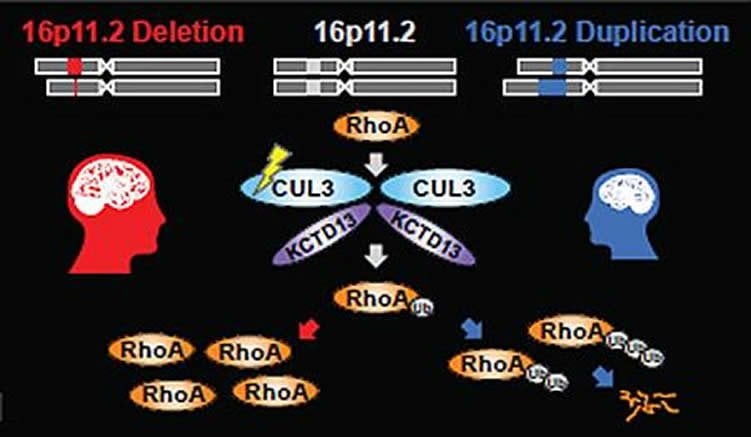Scientists at the University of California, San Diego School of Medicine have found that mutations that cause autism in children are connected to a pathway that regulates brain development. The research, led by Lilia Iakoucheva, PhD, assistant professor in the Department of Psychiatry, is published in the February 18 issue of Neuron.
The researchers studied a set of well-known autism mutations called copy number variants or CNVs. They investigated when and where the genes were expressed during brain development. “One surprising thing that we immediately observed was that different CNVs seemed to be turned on in different developmental periods,” said Iakoucheva.
Specifically, the scientists noted that one CNV located in a region of the genome known as 16p11.2, contained genes active during the late mid-fetal period. Ultimately, they identified a network of genes that showed a similar pattern of activation including KCTD13 within 16p11.2 and CUL3, a gene from a different chromosome that is also mutated in children with autism.
“The most exciting moment for us was when we realized that the proteins encoded by these genes form a complex that regulates the levels of a third protein, RhoA,” said Iakoucheva. Rho proteins play critical roles in neuronal migration and brain morphogenesis at early stages of brain development. “Suddenly, everything came together and made sense.”

Further experiments confirmed that CUL3 mutations disrupt interaction with KCTD13, suggesting that 16p11.2 CNV and CUL3 may act via the same RhoA pathway. RhoA levels influence head and body size in zebrafish, a model organism used by geneticists to investigate gene functions. Children with 16p11.2 CNV also have enlarged or decreased head sizes and suffer from obesity or are underweight. “Our model fits perfectly with what we observe in the patients,” said Guan Ning Lin, PhD, a fellow in Iakoucheva’s laboratory and co-first author with Roser Corominas, PhD.
Interestingly, the RhoA pathway has recently been implicated in a rare form of autism called Timothy syndrome, which is caused by the mutation in a completely different gene. “The fact that three different types of mutations may act via the same pathway is remarkable,” said Iakoucheva. “My hope is that we would be able to target it therapeutically.”
Iakoucheva and colleagues are planning to test RhoA pathway inhibitors using a stem cell model of autism. “If we can discover the precise mechanism and develop targeted treatments for a handful of children, or even for a single child with autism, I would be happy,” she said.
Co-authors include Xinping Yang, David E. Hill and Marc Vidal, Dana-Farber Cancer Institute; Irma Lemmens and Jan Tavernier, Ghent University, Belgium; and Jonathan Sebat, Beyster Center for Genomics of Psychiatric Diseases and UCSD.
This research was funded, in part, by National Institutes of Health (grants R01MH091350, R01HD065288, R21MH104766 and R01MH105524).
For more information about the Dana-Farber Cancer Institute, please visit their website.
Contact: Scott LaFee – UCSD
Source: UCSD press release
Image Source: The image is credited to UC San Diego School of Medicine and is adapted from the press release with the usage restriction: Use photo credit as indicated
Original Research: Abstract for “Spatiotemporal 16p11.2 Protein Network Implicates Cortical Late Mid-Fetal Brain Development and KCTD13-Cul3-RhoA Pathway in Psychiatric Diseases” by Guan Ning Lin, Roser Corominas, Irma Lemmens, Xinping Yang, Jan Tavernier, David E. Hill, Marc Vidal, Jonathan Sebat, and Lilia M. Iakoucheva in Neuron. Published online February 18 2015 doi:10.1016/j.neuron.2015.01.010






